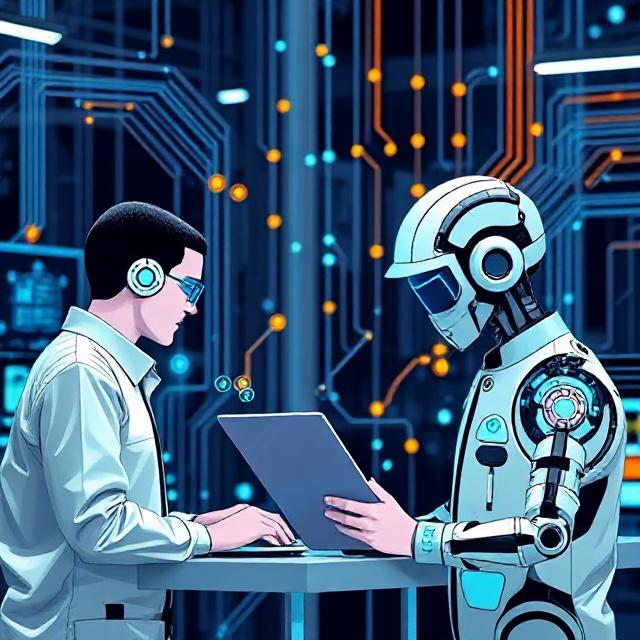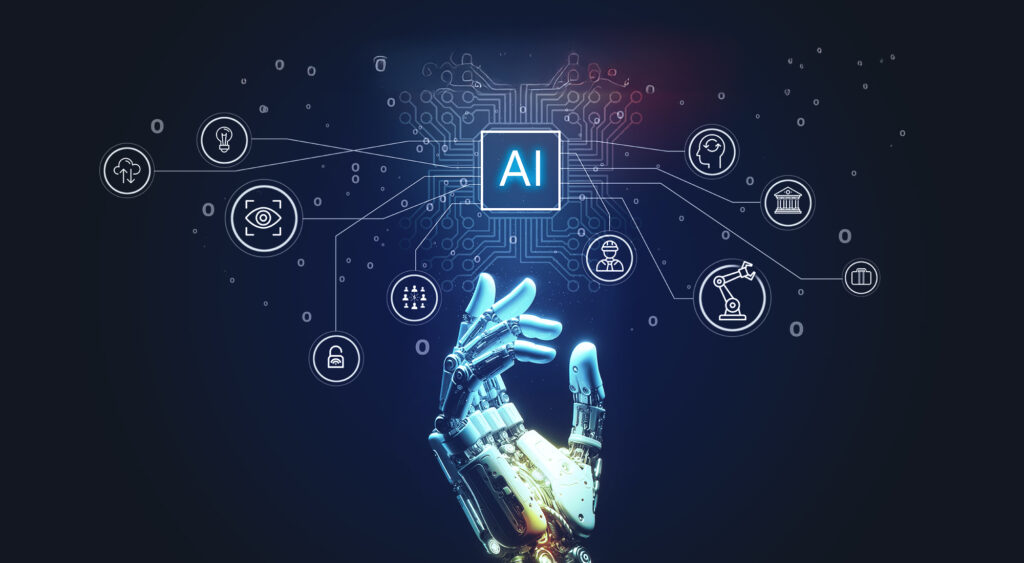Introduction

(Hook) We’ve all been there. It’s 11 PM, your website is malfunctioning right before a deadline, and the only “help” available is a frustrating loop of automated messages and a promise that “an agent will be with you in 47 minutes.” This experience is what many fear when they hear about Artificial Intelligence (AI) in customer support—the prospect of being permanently trapped in a digital maze, never reaching a human.
But what if AI could actually be the key to solving this very problem? The question isn’t just theoretical; it’s being answered in contact centers worldwide. This post will move beyond the hype and fear to ask a critical question: Is AI poised to replace your customer support team completely?
The evidence points to a more nuanced and powerful reality. AI is not a replacement for human empathy and complex problem-solving; instead, it is the most significant force multiplier the customer service industry has ever seen. By examining real-world case studies from leading companies, we will demonstrate how the future of customer support lies not in an “us vs. them” battle, but in a strategic collaborative model where AI handles the routine, and humans are empowered to handle the complex. This synergy is creating faster resolutions, lower costs, and, counterintuitively, a more human-centric customer experience.
1. The Rise of the AI Copilot: Enhancing, Not Replacing

Before diving into case studies, it’s crucial to understand the fundamental strengths and weaknesses of both AI and human agents. Viewing them as tools for different jobs is the first step to building a future-proof support strategy.
What AI Excels At: The Unbeatable Digital Workhorse
AI-powered customer support tools, primarily driven by Natural Language Processing (NLP) and Machine Learning (ML), are exceptionally good at specific, high-volume tasks.
- 24/7 Instant Responses and Scalability: Unlike human teams constrained by shifts, time zones, and hiring cycles, an AI chatbot or voice assistant can handle thousands of simultaneous conversations without fatigue. This provides always-on support for global customers, answering questions at the moment they arise, whether it’s 3 PM or 3 AM. This is invaluable for lead generation, basic FAQs, and preventing customer frustration outside business hours.
- Handling High-Volume, Repetitive Queries (Tier-1 Support): A significant portion of support tickets is repetitive. Questions like “What’s my order status?”, “How do I reset my password?”, “What are your store hours?” or “Do you ship to my country?” follow predictable patterns. AI can instantly access databases and provide accurate, consistent answers to these queries millions of times a day, freeing up human agents for more meaningful work.
- Multilingual Support at Scale: For businesses operating internationally, hiring fluent human agents in dozens of languages is prohibitively expensive and complex. AI translation and multilingual models can provide immediate, reasonably accurate support in a vast array of languages, breaking down barriers and opening up new markets without a proportional increase in staffing costs.
- Data Analysis for Personalization: AI can analyze a customer’s past interactions, purchase history, and browsing behavior in real-time. This allows it to personalize interactions. For example, a chatbot can greet a user by name, suggest relevant products based on their past purchases, or proactively notify them of a delay with their specific order number, creating a sense of individual attention.
The Human Irreplaceables: The Nuanced Problem-Solvers
Despite AI’s prowess, certain aspects of customer support remain firmly in the human domain. These are the skills that build loyalty and trust.
- Complex Problem-Solving & Critical Thinking: When a customer’s issue falls outside the pre-defined scripts and training data of an AI, the system will struggle. A human agent can think laterally, connect disparate pieces of information, understand the context of a unique software bug, and devise a creative solution that no AI could be programmed to handle.
- Empathy, Emotional Intelligence, and De-escalation: This is the cornerstone of human support. AI can be programmed to mimic empathy with phrases like “I’m sorry to hear that,” but it does not feel the customer’s frustration, anger, or anxiety. A human agent can hear the tremor in a customer’s voice, sense their growing frustration in a chat, and genuinely empathize. They can de-escalate a tense situation, apologize sincerely, and build an emotional connection that turns an angry customer into a loyal advocate.
- Handling Nuanced Complaints and Unprecedented Issues: A complaint like, “The tone of your marketing email was inappropriate and alienating,” requires a nuanced understanding of social context, brand voice, and subjective experience—things AI cannot grasp. Similarly, a completely new, unprecedented problem (e.g., a service outage due to a rare cosmic event) requires human judgment and accountability to navigate and communicate effectively.
2. Real-World Case Studies: The AI-Human Partnership in Action

Theory is one thing; practice is another. Let’s look at how leading companies are successfully implementing this hybrid model.
Case Study 1: The E-commerce Giant (e.g., Shopify)
The Challenge: E-commerce platforms and large retailers face an immense volume of pre-and post-purchase queries. Their human support teams were overwhelmed with repetitive questions, leading to long wait times and agent burnout.
The AI’s Role: Companies like Shopify have integrated AI-powered chatbots and help centers directly into their merchant and customer interfaces. These AI tools are designed to handle a wide array of routine tasks:
- Order Management: Providing real-time tracking updates, delivery estimates, and tracking numbers.
- Returns & Exchanges: Guiding customers through the self-service return process, generating labels, and explaining policy.
- Product FAQs: Answering questions about sizing, materials, inventory, and compatibility.
- Basic Troubleshooting: Helping merchants with simple setup tasks for their online stores.
The Human Handoff: The system is programmed to recognize keywords and sentiment that indicate a complex issue. Triggers for a seamless handoff to a live human agent include:
- A customer explicitly typed “I want to speak to a person.”
- Queries containing words like “complaint,” “defective,” “not as described,” or “manager.”
- A customer repeating the same question, indicating the AI hasn’t understood (a sign of frustration).
- Complex payment or discount issues that require manual override.
The Result: By implementing this strategy, one major e-commerce player reported deflecting over 40% of its routine queries. This had a cascading positive effect:
- For Customers: Faster answers to simple questions and reduced wait times to speak with a human for complex issues.
- For Agents: Reduced burnout from monotonous work. Agents could now focus on high-value, relationship-saving interactions that required empathy and critical thinking, leading to higher job satisfaction.
- For the Business: Significant reduction in support costs per ticket and an improvement in overall Customer Satisfaction (CSAT) scores.
Case Study 2: The SaaS Platform (e.g., Intercom)
The Challenge: Software-as-a-Service (SaaS) companies need to provide immediate technical support to users who are often in the middle of a time-sensitive task. Slow support can lead to churn.
The AI’s Role: Intercom, a leader in customer messaging, uses its own AI technology, the Fin AI chatbot, to power its support. The AI is deeply integrated with the company’s knowledge base and product data. Its functions include:
- Automated Troubleshooting: Answering “how-to” questions and guiding users through step-by-step solutions within the product.
- Intelligent Article Suggestion: Automatically surfacing the most relevant help documentation based on the user’s query.
- Qualifying and Routing Leads: Answering pre-sales questions and routing high-intent leads to the correct sales team.
The Human Handoff: The AI is sophisticated enough to understand its own limitations. It hands off a conversation to a human agent when:
- The problem requires accessing sensitive account information or making a configuration change that the AI isn’t authorized to do.
- A user asks a multi-layered question about their specific use case or custom setup.
- The AI detects negative sentiment, such as frustration from a user who can’t resolve their issue after several attempts.
The Result: Intercom has reported that their AI resolver can answer over 50% of all support questions automatically without any human intervention. This has led to a dramatic decrease in first-response time (often to zero) for a majority of queries. The support team is no longer a bottleneck; they are a specialized unit handling the most challenging and valuable user problems, which has a direct positive impact on customer retention and loyalty.
Case Study 3: The Banking Sector (e.g., Bank of America’s Erica)
The Challenge: Banks receive millions of routine inquiries about balances, transactions, and payments. Handling these through call centers is incredibly costly and time-consuming for both customers and the bank.
The AI’s Role: Bank of America’s AI virtual assistant, “Erica,” is a prime example of AI in a high-stakes, trusted environment. Accessed via the mobile app, Erica provides:
- Real-Time Account Information: Checking balances and recent transactions.
- Spending Insights and Categorization: Helping users understand their financial habits.
- Credit Score Education and Updates.
- Proactive Fraud Alerts: Flagging suspicious activity instantly.
- Bill Payment Assistance and Scheduling.
The Human Handoff: In the sensitive context of banking, the handoff protocol is critical. Erica seamlessly connects a user to a live specialist for:
- Loan Applications and Mortgage Advice: Complex financial products requiring human judgment and regulatory compliance.
- Disputing Complex Fraudulent Charges: Situations that require a sworn statement and detailed investigation.
- Financial Planning and Investment Advice: Personalized guidance that goes beyond automated insights.
The Result: Erica has successfully handled hundreds of millions of client requests since its launch. It has enhanced customer convenience by putting basic banking information at their fingertips 24/7, while simultaneously freeing up financial specialists in branches and call centers to focus on advisory and revenue-generating services, fundamentally transforming the role of the bank teller into a financial consultant.
3. The Hybrid Model: The Winning Strategy for Modern Support

The case studies above all share a common blueprint: the Hybrid Model. Implementing this successfully requires more than just buying a chatbot; it requires a strategic overhaul.
- The “AI Tier 1 / Human Tier 2” Structure: This is the operational backbone. AI acts as the first line of defense, the ultimate triage system. It resolves what it can instantly and efficiently filters and routes only the complex, high-touch issues to the human team. This structure ensures that human intelligence is applied where it adds the most value.
- Seamless Handoff Protocols: A clunky handoff where the customer has to repeat their entire story is a recipe for frustration. The key is context preservation. The AI must pass the entire conversation history, user data, and its own diagnosis attempts to the human agent. This allows the agent to pick up the conversation with, “Hi, I see you were working with our assistant on your delayed order #12345. Let me look into that for you right now,” instead of, “How can I help you?”
- Using AI as an Agent Assist Tool: The collaboration doesn’t end at the handoff. The most advanced systems use AI to empower the human agents themselves. Real-time agent assist tools listen in on live chats or calls and automatically suggest knowledge base articles, responses, and troubleshooting steps to the agent. This reduces their average handle time, improves accuracy, and serves as a continuous training tool.
Conclusion
The evidence is clear and overwhelming. The question “Can AI replace customer support?” is the wrong one to ask. The right question is, “How can we best integrate AI to augment and empower our human support team?”
AI is not the terminator of customer service jobs; it is the most powerful copilot ever created. It excels at scale, speed, and consistency for routine tasks. Humans excel at empathy, complex reasoning, and building trust. The future belongs to organizations that can seamlessly weave these two strengths together.
The goal is not to create a fully automated, impersonal support system. The goal is to use automation to eliminate the tedious parts of the customer journey, thereby creating the space and capacity for more meaningful, empathetic, and strategic human interactions. In this new paradigm, customers get the instant answers they crave for simple issues and the expert, compassionate help they need for complex ones. And support agents? They get to do more of what they do best: solve hard problems and connect with people on a human level. That’s a future worth building.



0 Comments